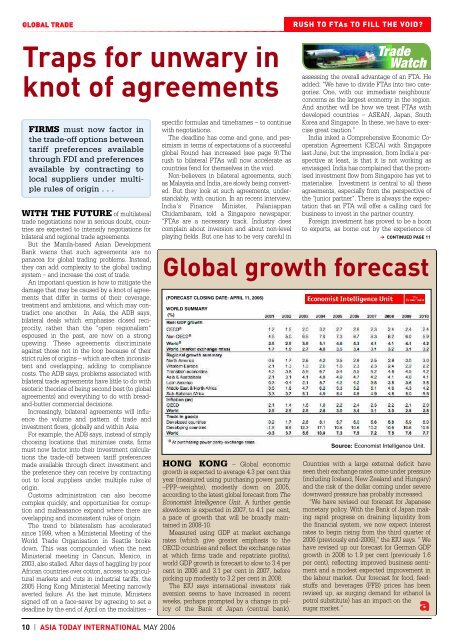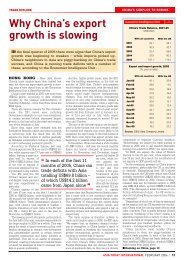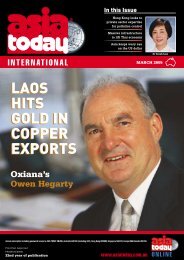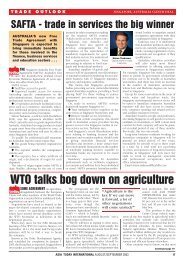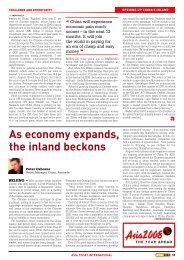d - Asia Today International
d - Asia Today International
d - Asia Today International
You also want an ePaper? Increase the reach of your titles
YUMPU automatically turns print PDFs into web optimized ePapers that Google loves.
GLOBAL TRADE<br />
RUSH TO FTAs TO FILL THE VOID?<br />
Traps for unwary in<br />
knot of agreements<br />
FIRMS must now factor in<br />
the trade-off options between<br />
tariff preferences available<br />
through FDI and preferences<br />
available by contracting to<br />
local suppliers under multiple<br />
rules of origin . . .<br />
WITH THE FUTURE of multilateral<br />
trade negotiations now in serious doubt, countries<br />
are expected to intensify negotiations for<br />
bilateral and regional trade agreements.<br />
But the Manila-based <strong>Asia</strong>n Development<br />
Bank warns that such agreements are no<br />
panacea for global trading problems. Instead,<br />
they can add complexity to the global trading<br />
system – and increase the cost of trade.<br />
An important question is how to mitigate the<br />
damage that may be caused by a knot of agreements<br />
that differ in terms of their coverage,<br />
treatment and ambitions, and which may contradict<br />
one another. In <strong>Asia</strong>, the ADB says,<br />
bilateral deals which emphasise closed reciprocity,<br />
rather than the "open regionalism"<br />
espoused in the past, are now on a strong<br />
upswing. These agreements discriminate<br />
against those not in the loop because of their<br />
strict rules of origins – which are often inconsistent<br />
and overlapping, adding to compliance<br />
costs. The ADB says, problems associated with<br />
bilateral trade agreements have little to do with<br />
esoteric theories of being second best (to global<br />
agreements) and everything to do with breadand-butter<br />
commercial decisions.<br />
Increasingly, bilateral agreements will influence<br />
the volume and pattern of trade and<br />
investment flows, globally and within <strong>Asia</strong>.<br />
For example, the ADB says, instead of simply<br />
choosing locations that minimise costs, firms<br />
must now factor into their investment calculations<br />
the trade-off between tariff preferences<br />
made available through direct investment and<br />
the preference they can receive by contracting<br />
out to local suppliers under multiple rules of<br />
origin.<br />
Customs administration can also become<br />
complex quickly, and opportunities for corruption<br />
and malfeasance expand where there are<br />
overlapping and inconsistent rules of origin.<br />
The trend to bilateralism has accelerated<br />
since 1999, when a Ministerial Meeting of the<br />
World Trade Organisation in Seattle broke<br />
down. This was compounded when the next<br />
Ministerial meeting in Cancun, Mexico, in<br />
2003, also stalled. After days of haggling by poor<br />
African countries over cotton, access to agricultural<br />
markets and cuts in industrial tariffs, the<br />
2005 Hong Kong Ministerial Meeting narrowly<br />
averted failure. At the last minute, Ministers<br />
signed off on a face-saver by agreeing to set a<br />
deadline by the end of April on the modalities –<br />
10 | ASIA TODAY INTERNATIONAL MAY 2006<br />
specific formulas and timeframes – to continue<br />
with negotiations.<br />
The deadline has come and gone, and pessimism<br />
in terms of expectations of a successful<br />
global Round has increased (see page 9).The<br />
rush to bilateral FTAs will now accelerate as<br />
countries fend for themselves in the void.<br />
Non-believers in bilateral agreements, such<br />
as Malaysia and India, are slowly being converted.<br />
But they look at such agreements, understandably,<br />
with caution. In an recent interview,<br />
India's Finance Minister, Palaniappan<br />
Chidambaram, told a Singapore newspaper:<br />
"FTAs are a necessary track. Industry does<br />
complain about inversion and about non-level<br />
playing fields. But one has to be very careful in<br />
Trade<br />
Watch<br />
assessing the overall advantage of an FTA. He<br />
added: "We have to divide FTAs into two categories.<br />
One, with our immediate neighbours’<br />
concerns as the largest economy in the region.<br />
And another will be how we treat FTAs with<br />
developed countries – ASEAN, Japan, South<br />
Korea and Singapore. In these, we have to exercise<br />
great caution.”<br />
India inked a Comprehensive Economic Cooperation<br />
Agreement (CECA) with Singapore<br />
last June, but the impression, from India's perspective<br />
at least, is that it is not working as<br />
envisaged. India has complained that the promised<br />
investment flow from Singapore has yet to<br />
materialise. Investment is central to all these<br />
agreements, especially from the perspective of<br />
the "junior partner". There is always the expectation<br />
that an FTA will offer a calling card for<br />
business to invest in the partner country.<br />
Foreign investment has proved to be a boon<br />
to exports, as borne out by the experience of<br />
➔ CONTINUED PAGE 11<br />
Global growth forecast<br />
(FORECAST CLOSING DATE: APRIL 11, 2006)<br />
WORLD SUMMARY<br />
(%)<br />
HONG KONG – Global economic<br />
growth is expected to average 4.3 per cent this<br />
year (measured using purchasing power parity<br />
–PPP–weights), modestly down on 2005,<br />
according to the latest global forecast from The<br />
Economist Intelligence Unit. A further gentle<br />
slowdown is expected in 2007, to 4.1 per cent,<br />
a pace of growth that will be broadly maintained<br />
in 2008-10.<br />
Measured using GDP at market exchange<br />
rates (which give greater emphasis to the<br />
OECD countries and reflect the exchange rates<br />
at which firms trade and repatriate profits),<br />
world GDP growth is forecast to slow to 3.4 per<br />
cent in 2006 and 3.1 per cent in 2007, before<br />
picking up modestly to 3.2 per cent in 2008.<br />
The EIU says international investors' risk<br />
aversion seems to have increased in recent<br />
weeks, perhaps prompted by a change in policy<br />
of the Bank of Japan (central bank).<br />
Source: Economist Intelligence Unit.<br />
Countries with a large external deficit have<br />
seen their exchange rates come under pressure<br />
(including Iceland, New Zealand and Hungary)<br />
and the risk of the dollar coming under severe<br />
downward pressure has probably increased.<br />
“We have revised our forecast for Japanese<br />
monetary policy. With the Bank of Japan making<br />
rapid progress on draining liquidity from<br />
the financial system, we now expect interest<br />
rates to begin rising from the third quarter of<br />
2006 (previously end-2006),” the EIU says. ” We<br />
have revised up our forecast for German GDP<br />
growth in 2006 to 1.9 per cent (previously 1.6<br />
per cent), reflecting improved business sentiment<br />
and a modest expected improvement in<br />
the labour market. Our forecast for food, feedstuffs<br />
and beverages (FFB) prices has been<br />
revised up, as surging demand for ethanol (a<br />
petrol substitute) has an impact on the<br />
sugar market.”


